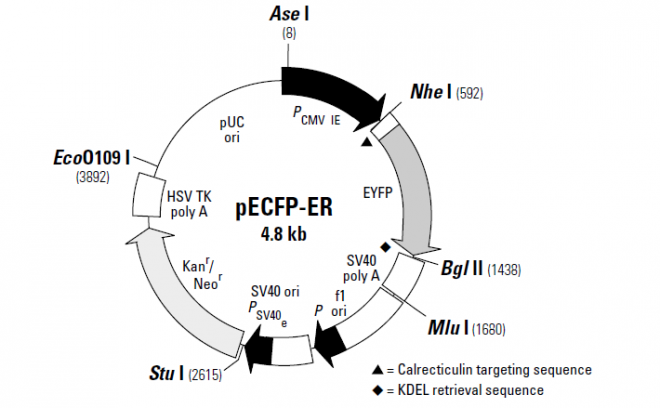
|
品牌 |
酶研生物 | |||||||||||||
货号 |
MY1131 | |||||||||||||
规格 |
2ug | |||||||||||||
价格 |
询价 | |||||||||||||
货期 |
现货 | |||||||||||||
pECFP-ER encodes a fusion protein consisting of enhanced cyan fluorescent protein (ECFP); the endoplasmic reticulum (ER) targeting sequence of calreticulin (1) cloned at the 5' end; and the sequence encoding the ER retrieval sequence, KDEL (2, 3), cloned at the 3' end. ECFP-ER is a soluble protein that localizes in the lumen of the ER in transfected cells. ECFP's fluorescence excitation maxima (major peak at 433 nm and a minor peak at 453 nm) and emission maxima (major peak at 475 nm and a minor peak at 501 nm) are similar to other cyan emission variants (4–6). ECFP also contains mutations to enhance the brightness and solubility of the protein, primarily due to improved protein-folding properties and efficiency of chromophore formation (5, 7, 8). In addition to the chromophore mutations, ECFP contains more than 190 silent base changes that correspond to human codon-usage preferences (9). SV40 polyadenylation signals downstream of the ECFP-ER fusion direct proper processing of the 3' end of the mRNA. The vector backbone also contains an SV40 origin for replication in mammalian cells expressing the SV40 T-antigen. A neomycin resistance cassette (Neor) consisting of the SV40 early promoter, the neomycin/ kanamycin resistance gene of Tn5, and polyadenylation signals from the herpes simplex virus thymidine kinase (HSV-TK) gene allow stably transfected eukaryotic cells to be selected using G418 (10). A bacterial promoter upstream of this cassette drives expression of the gene encoding kanamycin resistance in E. coli. The pECFP-ER backbone also provides a pUC origin of replication for propagation in E. coli and an f1 origin for single-stranded DNA production. 载体应用The pECFP-ER Vector is designed for fluorescent labeling of the endoplasmic reticulum in mammalian cells (11, 12). Fluorescence can be observed in living cells by microscopy. pECFP-ER can be introduced into mammalian cells using any standard transfection method. If required, stable transformants can be selected using G418 (10). Filter sets are available for dual-color detection of EYFP and ECFP using conventional epifluoresence microscopy (13). Please refer to the Living Colors® User Manual, provided with this vector, for additional information.
|
|
|||||||||||||










